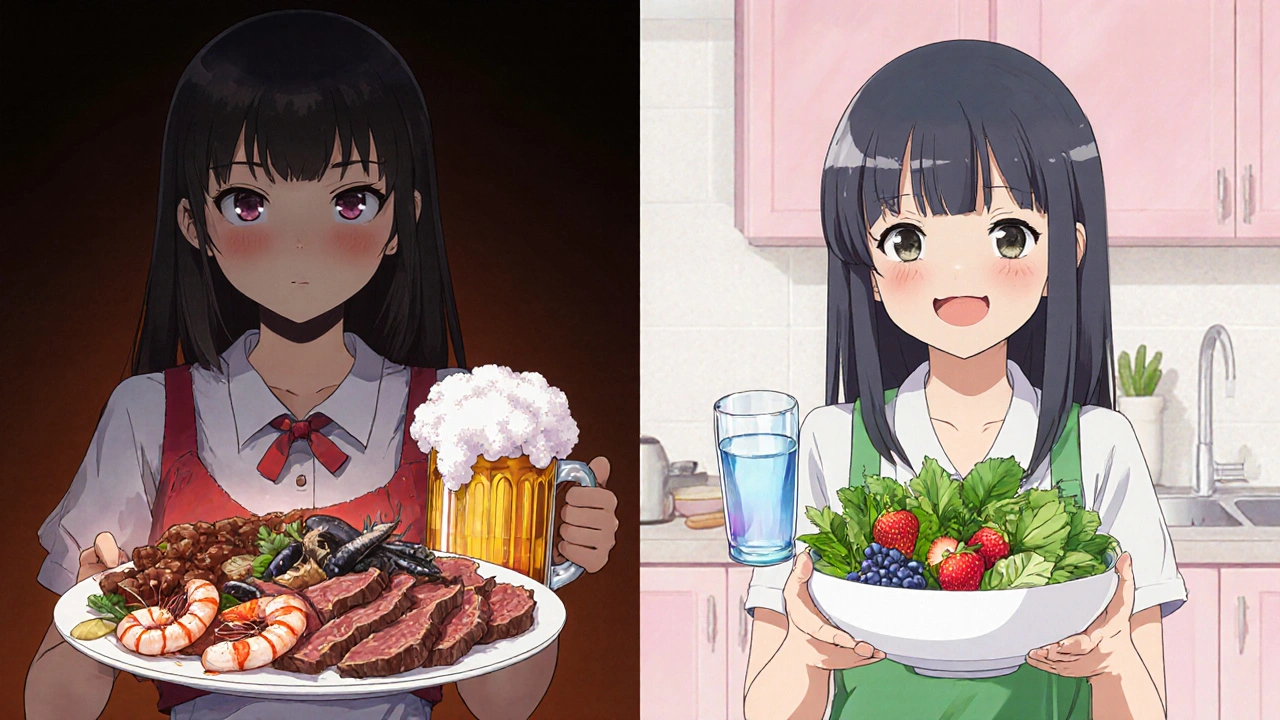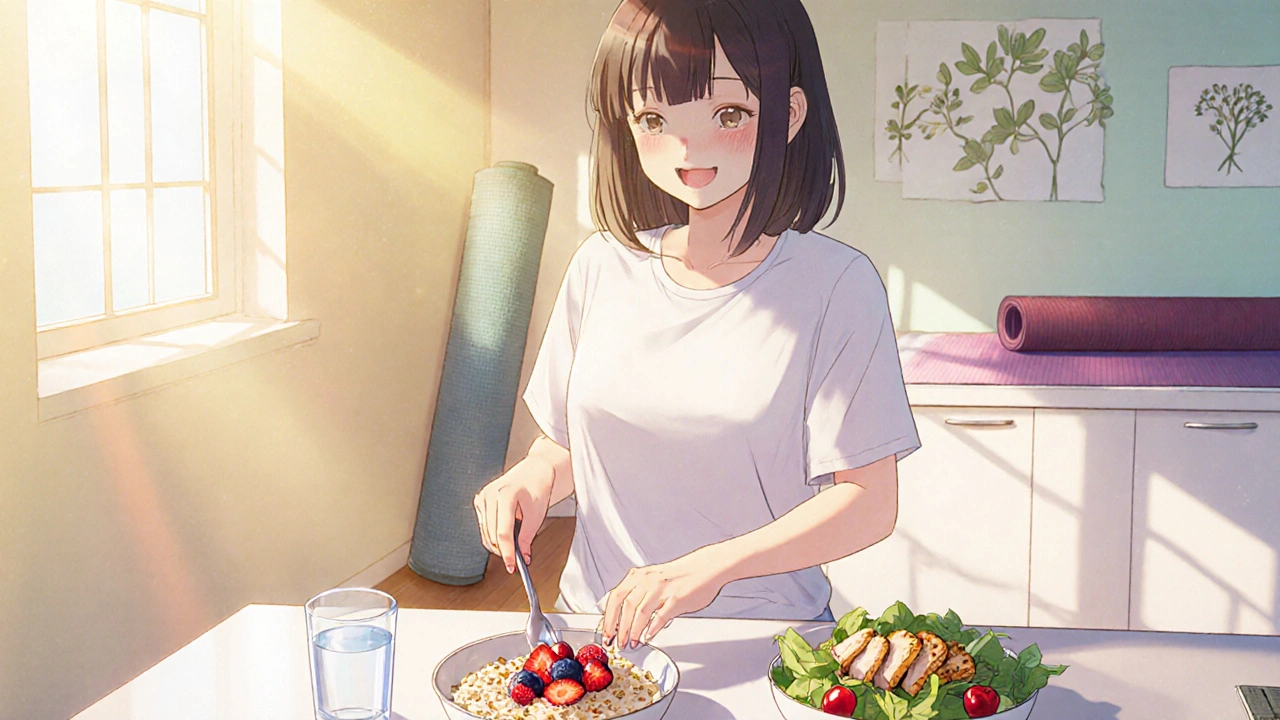Gout Purine Calculator
Calculate Your Daily Purine Intake
Select foods and beverages to estimate your daily purine intake. Aim to keep your total below 400mg per day for optimal gout management.
Imagine a sudden, burning ache in your big toe that leaves you wincing for hours. That’s gout in action, and the culprit is often what’s on your plate. Understanding the right gout diet can turn those flare‑ups into a thing of the past.
Key Takeaways
- Gout is caused by high levels of uric acid, which comes from the breakdown of purines.
- Animal proteins, certain seafood, alcohol, and sugary drinks are the biggest purine sources.
- Low‑purine fruits, vegetables, whole grains, and plenty of water can keep uric acid in check.
- Weight management, regular exercise, and, when needed, medication complement dietary changes.
Understanding Gout and Purines
Gout is a form of inflammatory arthritis that results from the deposition of monosodium urate crystals in joints. These crystals form when uric acid builds up in the bloodstream, a condition known as hyperuricemia. While genetics play a role, diet is the most modifiable risk factor.
Purines are natural compounds found in many foods and in our own cellular DNA. When your body digests purines, they break down into uric acid. The more purines you consume, the harder your kidneys have to work to excrete the resulting uric acid.
How Purines Turn Into Uric Acid
Inside every cell, purines exist as adenine and guanine. During normal turnover, these nucleotides are recycled, but a fraction ends up as hypoxanthine and xanthine, which are then oxidized by the enzyme xanthine oxidase into uric acid. This biochemical pathway explains why drugs like Allopurinol (a xanthine oxidase inhibitor) can lower uric acid levels.
The key takeaway: the more purine‑rich foods you eat, the higher the uric acid production, and the higher the chance that crystals will form.

Foods High in Purines
Not all proteins are created equal. Below is a quick reference of common foods and their average purine content per 100 g serving.
| Food | Purines (mg/100 g) | Typical Serving | Impact on Gout |
|---|---|---|---|
| Organ meats (liver, kidney) | 300‑400 | 50 g | Very high - avoid |
| Red meat (beef, pork, lamb) | 120‑150 | 100 g | High - limit to 2‑3 times/week |
| Shellfish (shrimp, crab, mussels) | 200‑250 | 100 g | High - choose sparingly |
| Anchovies & sardines | 250‑300 | 50 g | Very high - avoid |
| Beer & spirits | 60‑80 (per 12 oz) | 12 oz | Alcohol raises uric acid - limit |
| Fructose‑sweetened drinks | ≈ 45 (per 12 oz) | 12 oz | Increases uric acid production - avoid |
| Low‑fat dairy (milk, yogurt) | ≈ 15 | 200 ml | Low - may protect |
| Whole grains (brown rice, oats) | ≈ 20 | 1 cup cooked | Low - safe |
Low‑Purine Diet Tips You Can Start Today
- Choose plant‑based proteins. Lentils, chickpeas, and tofu are low‑purine alternatives that still give you protein.
- Swap red meat for white poultry (skinless chicken or turkey) - its purine level is about half that of beef.
- Make seafood a rare treat. If you crave fish, opt for low‑purine options like salmon or cod, and keep portions under 100 g.
- Drink plenty of water - aim for 2‑3 L daily to help kidneys flush uric acid.
- Limit alcohol, especially beer, which not only adds purines but also impairs uric acid excretion.
- Cut sugary sodas and fruit juices high in fructose; choose water, herbal tea, or coffee (coffee has a neutral to modestly protective effect).
- Include cherries or cherry juice - several studies show they can lower flare‑up frequency.
Common Myths & Pitfalls
Myth: All vegetables are safe. Reality: Most veggies are low in purines, but asparagus, spinach, and mushrooms have moderate levels. They’re okay in small servings.
Myth: Only meat causes gout. Reality: Alcohol and fructose are equally powerful triggers. Even a single sugary soda can tip the balance.
Myth: You must eat bland food forever. Reality: Flavor comes from herbs, spices, citrus, and low‑fat dairy. Experiment with ginger, turmeric, and garlic for anti‑inflammatory benefits.

Managing Gout Beyond Food
Diet alone rarely cures gout, but combined with lifestyle changes it makes a huge difference.
- Weight control. Losing 5‑10 % of body weight can drop uric acid by up to 0.5 mg/dL.
- Regular exercise. Low‑impact activities (walking, swimming) improve insulin sensitivity, which helps uric acid clearance.
- Medication. When diet isn’t enough, doctors may prescribe Allopurinol or newer agents like febuxostat. These should be taken under medical supervision.
- Stay hydrated. Dehydration concentrates uric acid, raising crystal risk.
Sample 7‑Day Low‑Purine Meal Plan
- Day 1: Breakfast - oatmeal with low‑fat milk and fresh berries; Lunch - mixed greens with grilled chicken, cherry tomatoes, and a citrus vinaigrette; Dinner - baked cod, quinoa, steamed broccoli.
- Day 2: Breakfast - Greek yogurt with sliced banana and a drizzle of honey; Lunch - lentil soup, whole‑grain roll; Dinner - stir‑fried tofu, bell peppers, brown rice.
- Day 3: Breakfast - whole‑grain toast, avocado, poached egg; Lunch - turkey sandwich on rye, side of carrot sticks; Dinner - grilled salmon, sweet potato mash, green beans.
- Day 4: Breakfast - smoothie with spinach, pineapple, low‑fat kefir; Lunch - quinoa salad with cucumber, feta, olives; Dinner - chicken kebabs, grilled zucchini, couscous.
- Day 5: Breakfast - cottage cheese with peaches; Lunch - chickpea salad with tahini dressing; Dinner - baked trout, barley pilaf, roasted carrots.
- Day 6: Breakfast - scrambled egg whites, tomato, whole‑grain English muffin; Lunch - vegetable minestrone soup; Dinner - pork tenderloin (small portion), mashed cauliflower, asparagus (lightly sautéed).
- Day 7: Breakfast - chia pudding with almond milk and kiwi; Lunch - mixed bean salad (black beans, kidney beans - limit to ¼ cup each) with lime; Dinner - shrimp (optional, very small portion) or extra tofu, brown rice, stir‑fried bok choy.
Adjust portions to fit your calorie needs, but keep total purine intake below 400 mg per day for most people.
Quick FAQ
Can I eat vegetables if I have gout?
Yes. Most vegetables are low in purines. Only a few-like asparagus, spinach, and mushrooms-have moderate levels, so enjoy them in moderation.
Is beer worse than wine for gout?
Beer contains both purines and alcohol, which together raise uric acid the most. Wine has less purine content, but alcohol still hampers uric acid excretion, so limit any alcoholic drink.
Do cherries actually help?
Research shows that regular consumption of tart cherries or juice can lower serum uric acid and reduce flare‑ups by about 30 %.
How much water should I drink daily?
Aim for at least 2 - 3 liters (8‑12 cups) of plain water a day, more if you exercise or live in a hot climate.
When is medication needed?
If uric acid stays above 9 mg/dL despite diet, or if you have frequent attacks, a doctor may prescribe Allopurinol, febuxostat, or uricosuric agents.
By keeping a watchful eye on purine‑rich foods and pairing smart eating habits with hydration, weight control, and (if needed) medication, you can tame gout and get back to living pain‑free.


Comments (6)
Shubhi Sahni
Welcome everyone, it's wonderful to see such interest in managing gout through nutrition, and I hope we can all share useful tips, because community support makes a big difference, especially when navigating complex dietary changes, so feel free to ask for clarification, and remember that small, consistent steps often lead to the biggest improvements in health.
Danielle St. Marie
Honestly, the guide is pretty basic-anyone with a minimal understanding of biochemistry would see that these suggestions are common sense, but let’s be clear: the U.S. health standards are superior, so if you’re not following American guidelines, you’re missing out 😎🇺🇸.
keerthi yeligay
Great summary, but cut the jargon a bit. Keep water high, avoid beer.
CASEY PERRY
While the recommendation to increase hydration aligns with renal clearance mechanisms, it is essential to quantify fluid intake relative to total daily osmolar load to ensure optimal uric acid excretion.
Naomi Shimberg
One must recognize that dietary modifications alone seldom suffice for sustained urate control.
kenny lastimosa
It is interesting to reflect on how lifestyle factors interplay with metabolic pathways, and perhaps we all underestimate how modest adjustments can shift the equilibrium toward lower serum urate.